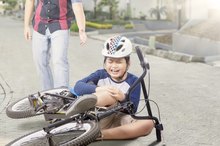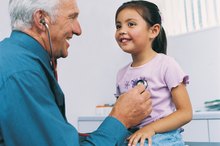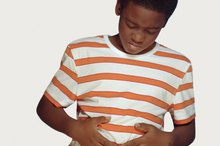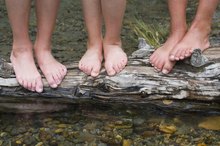Children's Pain in Thighs
Thigh pain on children is often caused by cramps, strains or growing pains. There are several steps you can take to reduce your child’s pain level when these conditions occur. If your child is having difficulties moving the leg or cries if the leg is touched, seek medical attention since a fracture is a possible cause of the pain.
If you are experiencing serious medical symptoms, seek emergency treatment immediately.
Identification
The two major muscle groups affected by thigh pain are the quadriceps and hamstrings. The quadriceps are located on the front of the thigh and the hamstrings are on the back of the thigh. A cramp in one of these muscles causes an involuntary contraction of the muscles, which results in an intense pain that usually last less than a minute. Sometimes the cramp can be felt with your hand or visibly noticeable as a hard lump on the muscle. A strained muscle is painful, tight and your child has limited range of motion. Depending on the severity of the injury, the pains from strained muscles can last hours to weeks. A strained thigh muscle can force your child to walk with a limp or not be able to walk at all. Sometimes a “pop” is felt during a hamstring injury.
Growing pains of the thigh have an aching sensation that usually occurs in both legs and is typically felt at night. A headache or abdominal pain sometimes accompanies this type of thigh pain.
- The two major muscle groups affected by thigh pain are the quadriceps and hamstrings.
- Sometimes a “pop” is felt during a hamstring injury.
Cause
How to Get Rid of Growing Pains
Learn More
The exact cause of cramps is unknown, but dehydration and tight muscles play a significant role in the development of a cramp. Dehydration is likely the reason children develop cramps during or after playing on hot days. A strain occurs when the thigh muscles are overstretched or torn.
Strains can also occur if the muscles are overused during strenuous activities. Growing pains have nothing to do with the body growing and occur in 10 percent of healthy children, according to the Seattle Children’s Hospital 1. Force placed on the muscles during vigorous play can cause soreness to your child’s muscoskeletal system, which is the reason pain is felt at night since strenuous activities were performed during the day.
- The exact cause of cramps is unknown, but dehydration and tight muscles play a significant role in the development of a cramp.
- Force placed on the muscles during vigorous play can cause soreness to your child’s muscoskeletal system, which is the reason pain is felt at night since strenuous activities were performed during the day.
Treatment
**A cramp disappears shortly after the contraction begins in the muscle.
** You can help ease your child’s cramp by stretching the affected muscle while massaging the cramp. Apply ice to the muscle if soreness persists after the cramp subsides. Give your child water if the cramp occurs on a hot day. If the quadriceps or hamstrings are strained, rest the leg for the first 48 hours following the injury. Ice the area for 20 minutes four times per day during the first 48 hours, but switch to a heating pad twice a day after 48 hours. The ice reduces inflammation, and the heat promotes healing.
Once the pain disappears, perform light stretches and some strengthening to the thigh muscles. Relief from growing pains differ child to child. **Some children are comforted by cuddling with a parent.
** Massage, a heating pad and a warm bath at bedtime can all provide relief from growing pains. Acetaminophen or ibuprofen can be administered for cramps, strains and growing pains. Never give a child aspirin since aspirin increases your child’s risk of Reye’s syndrome, which is potentially fatal.
- A cramp disappears shortly after the contraction begins in the muscle.
- Give your child water if the cramp occurs on a hot day.
Prevention
Causes of Leg Muscle Stiffness and Pain in Children
Learn More
**Reduce your child’s risk of cramps by encouraging your child to drink fluids several times per day — especially after physical activity.
Help your child stretch the thigh muscles every day and hold stretches for at least 30 seconds. ** Get your child involved in activities that encourage team stretching, such as gymnastics, dance, track and most sports.
The increased range of motion also reduces your child’s risk of a muscle strain. You are unable to prevent a child’s growing pains.
- Reduce your child’s risk of cramps by encouraging your child to drink fluids several times per day — especially after physical activity.
Related Articles
References
- Seattle Children’s Hospital: Leg Pain
- Palo Alto Medical Foundation: Parents & Teachers: Growing Pains
- Koh ZSD, Lin S, Hey HWD. Lumbar disc herniation presenting with contralateral symptoms: a case report. J Spine Surg. 2017;3(1):92-94. doi:10.21037/jss.2017.03.06
- Genevay S, Atlas SJ. Lumbar spinal stenosis. Best Pract Res Clin Rheumatol. 2010;24(2):253-65. doi:10.1016/j.berh.2009.11.001
- Sherry M. Examination and treatment of hamstring related injuries. Sports Health. 2012;4(2):107-14. doi:10.1177/1941738111430197
- Lavine R. Iliotibial band friction syndrome. Curr Rev Musculoskelet Med. 2010;3(1-4):18-22. doi:10.1007/s12178-010-9061-8
- Ryan AS, Buscemi A, Forrester L, Hafer-macko CE, Ivey FM. Atrophy and intramuscular fat in specific muscles of the thigh: associated weakness and hyperinsulinemia in stroke survivors. Neurorehabil Neural Repair. 2011;25(9):865-72. doi:10.1177/1545968311408920
- Centers for Disease Control and Prevention. Understanding Blood Clots. Updated March 14, 2019.
- Cherkin DC, Sherman KJ, Avins AL, et al. A randomized trial comparing acupuncture, simulated acupuncture, and usual care for chronic low back pain. Arch Intern Med. 2009;169(9):858-66. doi:10.1001/archinternmed.2009.65
- Lempainen L. Operative treatment for the painful posterior thigh after hamstring autograft harvesting. Muscles, Ligaments and Tendons Journal. 2017;7(3):570. doi:10.11138/mltj/2017.7.3.570
Writer Bio
Melissa McNamara is a certified personal trainer who holds a Bachelor of Arts in journalism and communication studies from the University of Iowa. She writes for various health and fitness publications while working toward a Bachelor of Science in nursing.









